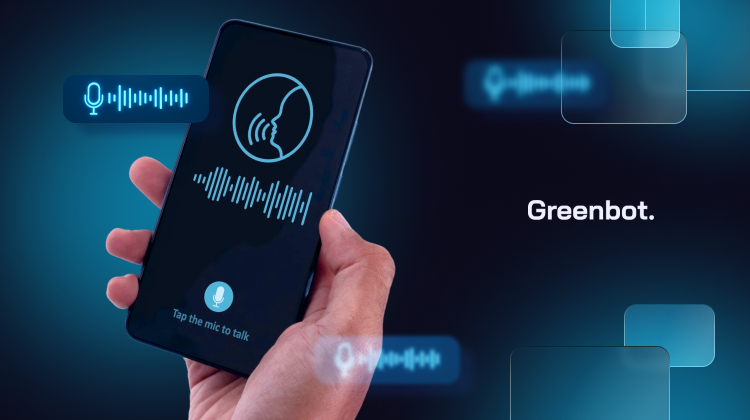
An AI voice generator turns text into realistic speech using natural language processing. It produces human-like audio for virtual assistants, learning tools, and digital content.
Its goal is to create voices that sound natural and engaging. AI voice technology focuses on intelligible speech to improve human-like interactions.
This article will cover the definition of AI voice generators, their working principles, common uses, customization options, safety and legal concerns, and comparisons with traditional text-to-speech tools.
What Is an AI Voice Generator?
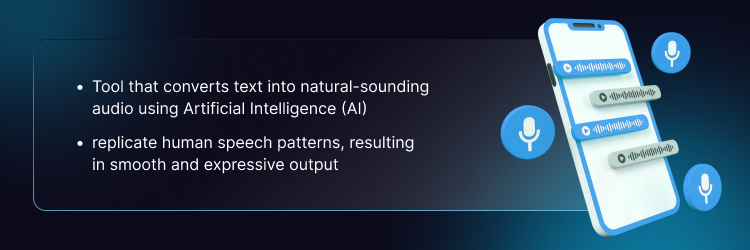
An AI voice generator is a tool that converts text into natural-sounding audio using artificial intelligence (AI) speech synthesis. It builds upon older text-to-speech tools, offering more control over tone, pitch, and clarity.
AI voice generators utilize advanced systems to replicate human speech patterns, resulting in smooth and expressive output. They allow for customization, creating voices that match context and personality.
How Does an AI Voice Work?
AI-generated voices rely on machine learning and deep learning models to convert written text into synthetic speech. These models are trained on vast datasets of voice samples to understand pitch, tone, and rhythm.
The system interprets the text using natural language processing and produces the speech using voice synthesis techniques. Over time, the models improve through exposure to more data, refining their ability to mimic natural speech.
Text-to-Speech vs. AI Voice Generation
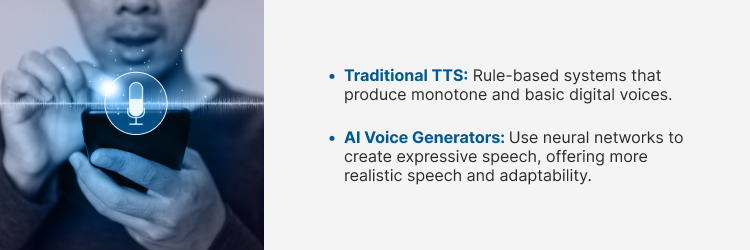
Traditional TTS and AI voice generators have distinct differences:
- Traditional TTS: Rule-based systems that produce monotone and basic digital voices.
- AI Voice Generators: Use neural networks to create expressive speech, offering more realistic speech and adaptability.
AI voice generators deliver generated speech that sounds more natural and versatile than traditional text-to-speech systems. They excel in use cases requiring dynamic, human-like voices, whereas TTS is typically limited to simpler applications.
What Is Voice Cloning?
Voice cloning utilizes artificial intelligence to replicate a person’s voice. The technology generates synthetic voices that sound like the original speaker by copying pitch, tone, accent, and style from voice recordings.
How Voice Cloning Works
Voice cloning starts with collecting high-quality recordings of a person’s voice. These samples help AI learn how they speak, including pitch, tone, and rhythm. The system uses this data to recreate a voice that sounds almost identical to the original.
Common Uses of Voice Cloning
Voice cloning is widely used in media for dubbing, narration, and AI voiceovers. In marketing, it helps create personalized voices for businesses, ensuring consistent audio branding across all channels. It’s also crucial for accessibility, as it allows users with disabilities to interact with tools that recreate natural-sounding voices.
Ethical Considerations in Voice Cloning
Using someone’s voice without consent is a significant ethical issue. Voice cloning can be misused to create deepfakes, leading to misinformation. It is crucial that companies obtain permission and use the technology responsibly to avoid misuse and protect individuals’ rights.
How to Use an AI Voice Generator
Using a voice generator is simple, even if you’ve never worked with speech tools before. Here’s a clear, step-by-step process for creating AI voices from written text and customizing them to fit your needs.
- Choose a Platform: Select a tool that fits your needs. There are free and premium options.
- Select a Voice: Pick a voice based on gender, accent, tone, or language.
- Input Your Text: Type or paste the text you want to convert into speech.
- Adjust Pitch, Tone, and Style: Fine-tune your voice by adjusting pitch, pacing, and emotional expression.
- Download or Embed the Audio: Once you’re satisfied, download the audio file or embed it into your content.
AI Voice Customization Features
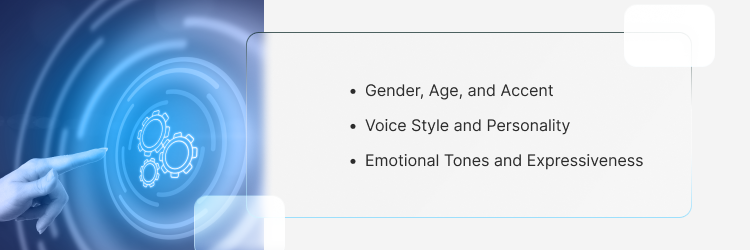
AI voice models enable users to fine-tune key aspects of the voice for enhanced personalization.
- Gender, Age, and Accent: Select from male, female, or child voices, and choose regional accents.
- Voice Style and Personality: Adjust the mood to be friendly, formal, energetic, or calm.
- Emotional Tones and Expressiveness: Add emotions like joy, sadness, or excitement for a more human-like voice.
What Can You Use AI Voice Generators For?
AI voice generators are used for various applications:
- eLearning: Read lessons aloud and improve accessibility.
- Audiobooks: Create engaging audiobook content.
- Virtual Assistants: AI-powered assistants, such as Alexa, offer natural responses.
- Podcasting & Video Narration: Produce consistent voiceovers for content.
- Accessibility Tools: Help those with vision or reading challenges by reading text aloud.
Benefits of AI Text-to-Speech Tools
AI text-to-speech tools offer a fast and cost-effective alternative to traditional voice actors. They support multiple languages and accents, enhancing accessibility and scaling across diverse audiences. These tools are also easy to update, allowing quick changes to content.
- Cost-effective: No need to hire voice actors for repetitive or lengthy content.
- Multiple languages and accents: Generate speech in various languages and dialects.
- Improves accessibility: Helps those with vision or reading challenges.
- Easy updates: Modify text and reprocess without re-recording.
AI Voices in Virtual Assistants and Devices
AI voice powers popular virtual assistants like Siri, Alexa, and GPS systems. These tools respond to voice commands and handle tasks in real-time. With natural language processing (NLP), these assistants understand context, providing smarter, more accurate responses. Voice AI helps create a seamless, interactive experience with interactive voice response.
Accessibility Features and Human Speech Simulation
AI voices play a crucial role in improving accessibility for users with visual, motor, or cognitive impairments. They help by reading content aloud with human-like speech.
Some systems also support voice cloning, recreating human speech patterns to make digital tools more personal. This makes content more accessible to those who might otherwise have difficulty engaging with it.
AI Voice in Customer Service
Businesses use AI voice technology in customer service. Voice bots and IVR systems handle questions, route calls, and fix basic issues—without needing humans. This boosts efficiency and speeds up responses.
These systems work 24/7 and sound more natural than old ones. AI voices sound smoother, making customer support feel more personal. The result is a faster, better experience with synthetic speech that feels more like human speech.
AI Voice for Content Creation and Marketing
Creators use AI voice generators for YouTube videos, explainer videos, and ads. These tools save time and give brands control over tone, pacing, and delivery. AI voiceover helps keep a consistent style across tutorials and product walkthroughs.
Some platforms allow custom voice acting with the user’s voice or branded tones. AI voice is also used in podcasting, turning scripts into spoken content. It speeds up production while maintaining a clear, consistent voice.
Are AI Voice Generators Legal?
Using an AI voice generator is legal, but it depends on how it’s used. Cloning someone’s voice without consent can break privacy laws and cause legal issues.
When used commercially, businesses must ensure they have the rights to the original voice data. Always get permission, respect copyright, and avoid voice cloning to mislead people.
Is It Safe to Use Voice AI?
Using voice AI can be safe, but there are risks. Data misuse and spoofing are concerns. Some platforms may store voice recordings, which could be misused.
To stay safe, choose the best AI voice generator with clear privacy policies. Make sure the platform lets you control your data and delete recordings.
Is There an AI Voice Generator Free to Use?
Yes, there are several free AI voice generator tools available. Some popular options include ElevenLabs, PlayHT, and Narakeet. These platforms let users test basic text to speech features at no cost.
However, free versions often come with limits. You may get fewer voice styles, shorter export lengths, or watermarked audio. To access full voice libraries and better controls, most users upgrade to paid plans. Still, free tools are a great way to try out the best AI voice options before committing.
Best AI Voice Generator Options
Here are some top AI voice generators to consider:
- ElevenLabs: Known for ultra-realistic voices and emotion control, great for storytelling.
- Speechify: Ideal for reading long documents aloud with adjustable speed and tone.
- WellSaid Labs: Offers polished professional voices for business and advertising use.
- Respeecher: Specializes in voice cloning for dubbing and media production.
- Altered: Provides flexible voice transformation tools for creators.
- Murf: All-in-one voice generator with script editing and audio syncing for marketing content.
Realism in AI Voices: Do They Sound Human?
Modern AI voices sound much more natural than early digital systems. Today’s tools use advanced modeling to mimic human-like voices with accurate pitch, tone, and emotion. These improvements help voices feel less robotic and more relatable.
Lifelike AI voices now handle pauses, stress, and intonation with ease. They can express emotion, shift pace, and match the flow of natural speech. The result is realistic speech that fits well in podcasts, videos, and digital assistants.
Behind the Scenes: AI Voice Models and Data
AI voice models are trained on large datasets of recorded speech. These datasets teach voice models how to mimic human speech patterns. Neural networks and large language models (LLMs) use this data for voice synthesis, helping generate more natural and context-aware speech. Diverse datasets are key to making voices sound natural and reducing bias.
Future of AI Voice Technology
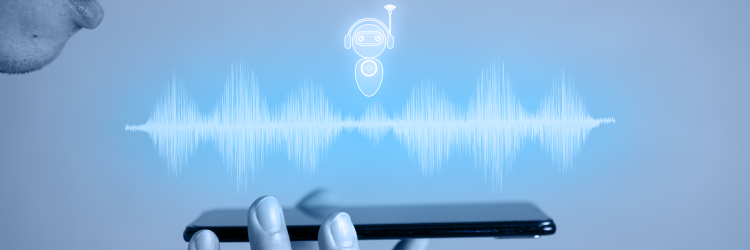
The future of AI voice technology looks exciting. We might see real-time translation, AI avatars, and voice cloning that adapts to your emotions. Natural language processing will keep improving, making voice AI even more personalized and human-like.
FAQs About AI Voice Generator
Is it legal to use AI voice?
Yes, but it depends on how you use it. Using someone else’s voice without consent could break privacy or copyright laws. Always get permission, especially when using voice cloning for commercial work.
What is the difference between text to speech and AI voice generation?
Text to speech reads words out loud using basic rules and voice templates. AI voice generation uses advanced models to create natural, expressive speech that sounds more human.
What is voice cloning?
Voice cloning means copying a real person’s voice using recordings. It allows AI to speak in that person’s tone, pitch, and accent. This is often used for accessibility or creating custom voices.
What can AI voice be used for?
AI voice tools are used in podcasts, explainer videos, learning tools, and virtual assistants. They help turn text into speech quickly, saving time for creators and teams.
Are AI voices safe?
Most platforms are safe to use, but users should be careful with how their data is handled. Choose trusted tools and avoid uploading private or sensitive voice recordings.
Final Thoughts
AI voice technology is transforming how we create and interact with content. From voice generation to AI generated voices, it provides realistic speech that mirrors human voices. With text to speech and expressive AI voices for branding, the possibilities are endless.
Thanks to natural language processing (NLP), AI voices sound natural and adaptable. Explore AI voice and discover how it can make your spoken words sound just like your own voice.





















